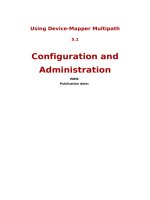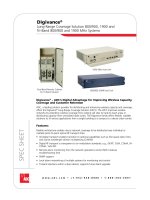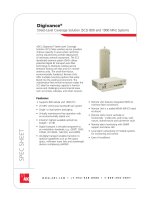Tài liệu Digivance® pptx
Bạn đang xem bản rút gọn của tài liệu. Xem và tải ngay bản đầy đủ của tài liệu tại đây (393.59 KB, 8 trang )
www.adc.com • +1-952-938-8080 • 1-800-366-3891
SPEC SHEET
Digivance
®
Street-Level Coverage Solution (SCS) 800 and 1900 MHz Systems
ADC’s Digivance
®
Street-Level Coverage
Solution (SCS) helps wireless service providers
improve capacity in areas where restrictive
zoning requirements prohibit deployment
of necessary network equipment. The SCS
distributed antenna system (DAS) utilizes
patented digital RF transport-over-fiber
technology to distribute wireless service
between existing cell sites and SCS remote
antenna units. The small-form-factor,
environmentally hardened, Remote Units
offer multiple mounting options that easily
blend into the existing environment. The
maintenance-free remote enclosure makes the
SCS ideal for improving capacity in hard-to-
access and challenging environmental areas
such as tunnels, subways, and urban canyons.
Features:
• Supports 800 cellular and 1900 PCS
• 25 MHz continuous bandwidth per system
• Single- or dual-system packaging
• Virtually maintenance-free operation with
an environmentally sealed unit
• Industry’s highest available optical loss
budget – 25 dB
• Digital transport is virtually transparent to
air modulation standards; e.g., iDEN
®
, GSM,
CDMA, W-CDMA, 1xEV-DO, and HSDPA
• All-digital transport enables transition to
optional capabilities such as free space
optics, millimeter wave links and wavelength
division multiplexing (xWDM)
• Remote Unit features integrated WDM to
minimize fiber connections
• Remote Unit is a sealed NEMA 6/IP-67 rated
enclosure
• Remote Units mount vertically or
horizontally - inside pole, pole wrap, wall-
mount, strand-mount and sub-terrain vault
• Remote alarm monitoring with SNMP
support and status LED
• Local alarm networking of multiple systems
for monitoring and control
• Ease of installation
8/06 • 102981AE
Digivance
®
Street-Level Coverage Solution
2
www.adc.com • +1-952-938-8080 • 1-800-366-3891
Digivance
®
Street-Level Coverage Solution (SCS) 800 and 1900 MHz Systems
Overview
With increased popularity and reliance on wireless
devices, subscribers expect to have service at any
time, in any place. This requires service providers
to increase capacity and coverage, which is
typically done by adding new cell sites. However,
with city centers becoming more congested and
local government zoning regulations becoming
more stringent, obtaining permits for new
wireless cell sites is becoming increasingly more
difficult. Extending service to these hard-to-reach
areas often requires overcoming major challenges.
The SCS is a cost-effective solution for extending
or distributing capacity from base stations to
other areas that require coverage.
Application
Digivance is the only all-digital DAS available
today. By using patented technology, the SCS
digitizes the entire designated RF band, digitally
transports it over fiber, and reconstructs the
signal at full bandwidth, regardless of modulation
technology. Digital RF transport allows the
signals to be replicated at full dynamic range,
independent of the fiber length, which improves
data throughput. As advanced, high data-rate
broadband services become available, networks
with ADC’s SCS technology will be ready.
ADC’s digital RF transport technology
accommodates enhancements such as free space
optical laser links, millimeter wave links and
xWDM capabilities. The xWDM option allows
multiple transmit and receive paths over a single
fiber cable, potentially
reducing annual fiber
lease costs. Free space
optical laser links and
millimeter wave solutions
overcome fiber availability
issues.
The SCS offers all
the benefits of digital
technology in a
maintenance-free,
compact Remote Unit. Its
versatility and small size
allow service providers to
quickly deploy networks in
challenging service areas.
Centralization of base
station capacity can also
be realized using the SCS.
This allows service providers to further benefit
by reducing capital expenditures and annual
operating costs. Base station radio capacity may
be simulcast to multiple remotes by using RF
splitting and combining capabilities. The SCS is a
cost effective way to solve coverage and capacity
problems without assuming the capital expense
and time it takes to deploy additional cell sites.
System Description
The SCS optically transports digitized RF signals
to difficult coverage areas such as congested
city center locations, tunnels, and canyons. One
point-to-point RF transport link consists of a Host
Unit and corresponding Remote Unit.
The SCS Host Unit is typically rack-mounted
at the base transceiver station (BTS) site or
collocated with other Host Units at a centralized
base station radio (BR) suite. The RF signal
is transported digitally over fiber optic cable
connecting the host to a SCS Remote Unit.
The SCS Remote Unit is positioned at the area
requiring coverage and interfaces with an
antenna to distribute the RF signal. The distance
between the SCS Host Unit and Remote Unit is
typically limited only by time delay requirements
of system modulation standards (iDEN
®
, GSM,
CDMA, W-CDMA, 1xEV-DO, and HSDPA, etc.),
and can be as far as several kilometers. With the
product’s 25 dB optical budget, the SCS can be
deployed in the most challenging fiber plants.
Dual-band Enclosure
Dual-WDM
1310nm and 1550nm
Host Unit 1900 MHz
Host Unit 800 MHz
RF interface panel
EMS or SNMP
RX TX
Wireless
Base Station
Internal WDM
One fiber per band
RF Signals
Coax Cable
Internal diplexor to
one RF output
Optional external
UPS/battery backup
Antenna
Antenna Standoff
Dual-band enclosure with two frequency bands
8/06 • 102981AE
Digivance
®
Street-Level Coverage Solution
3
www.adc.com • +1-952-938-8080 • 1-800-366-3891
Host Unit
The rack-mounted SCS Host Unit is typically
located at a BTS or a facility housing a suite of
BTSs. On the forward path, the Host Unit digitizes
the designated RF band and digitally transports
it over singlemode fiber to the SCS Remote Unit.
On the reverse path, the Host Unit receives the
digitized signal and converts it to RF. The Host
Unit also collects alarm information from the
Remote Unit.
For system deployments, multiple links can be
networked together at the same BTS site. Host
Units can be daisy-chained together to allow
monitoring and control of multiple links from a
single-user interface.
Remote alarm monitoring and control of the
SCS can be managed from an off-site location
or NOC. Using a standard PC with a standard
physical layer protocol, communications can be
delivered to the NOC. In addition to sending
alarm notifications to the Digivance EMS through
software, the SCS Host Unit also features front
panel alarm reporting. LEDs on the front panel
of the Host Unit will change color depending
on the status of the unit. LED displays provide
information regarding the following items:
• Power
• System mode (active/standby)
• Indication of faulty unit
• RF conditions
Furthermore, alarm contact closures provide
major and minor alarms. The Host Unit has two
alarm contacts that either report system operation
is seriously affected (major alarm) or system
operation is degraded (minor alarm). The Host
Unit operates on DC power.
Remote Unit
The small-form-factor SCS Remote Unit minimizes
visual pollution and offers multiple mounting
options that easily blends into the environment.
Mounting options for the single- and dual-system
remotes include inside pole-mount, pole-wrap,
wall-mount, strand-mount and sub-terrain vault-
mount capabilities. The Remote Units can be
mounted in a vertical or horizontal position in less
than five minutes, are sealed NEMA 6/IP-67 rated
enclosures that can be deployed in the harshest
environments. Fiber, antenna, and power input/
output connectors are all sealed for maximum
protection.
For installations in areas with significant solar
load, ADC offers a solar shield shroud to protect
the SCS.
On the forward path, the Remote Unit receives
the digitized signals from the Host Unit and
converts the signal back into RF to be distributed
via an externally mounted antenna. On the
reverse path, the Remote Unit digitizes the
designated RF band and digitally transports it over
singlemode fiber to the Host Unit.
In addition to sending alarm notifications to the
EMS software, the SCS Remote Unit also features
LED alarm reporting. An LED on the bottom
of the Remote Unit will illuminate upon a fault
condition. The LED will display information about
the following:
• System mode (active/standby)
• Indication of faulty unit
• RF conditions
• Power amplifier fault
• Antenna fault system (VSWR)
Digivance
®
Street-Level Coverage Solution (SCS) 800 and 1900 MHz Systems
8/06 • 102981AE
Digivance
®
Street-Level Coverage Solution
4
www.adc.com • +1-952-938-8080 • 1-800-366-3891
Alarming and Management
ADC's Digivance
®
Element Management
System (EMS) provides operational and
maintenance capability for the SCS. The
EMS consists of a personal computer (PC)
using a Windows
®
operating system, ADC
furnished Java-based software package;
an ASCII based RS-232 capable terminal,
and RS-232 cables.
The EMS can simultaneously monitor a
network of SCS links by daisy-chaining
the alarm interfaces of up to 24 SCS
Host Units. Each of the Host Units
are connected through a controller
area network bus and the PC can be
connected to any of the Host Units. The
EMS has the ability to download software,
change parameters, and monitor alarms.
The EMS provides three levels of alarms:
software reporting, LEDs and external contacts.
Using a laptop PC, the EMS can also be used
for field test and troubleshooting at each SCS
Remote Unit. Additionally, off-site functionality
is accomplished through a terminal at the NOC
using a PC with a standard physical layer protocol
for the communications.
ADC offers a complete EMS hardware
and software turnkey solution to element
management, as well as a software solution,
where operators utilize their existing element
management network.
Host Site Capabilities
The EMS performs the following functions at the
host site:
• Provides real-time information regarding faults
• Displays various system level values (voltages,
RF, power, etc.)
• Records and generates history reports
with time and date stamps
• Adjusts performance related parameters
of the Host Unit and Remote Unit
• Permits placement of Host Unit and
Remote Unit into standby mode
• Allows download of new software
versions to the Host Unit and Remote
Units
Off-Site Capabilities
The EMS performs the following functions at off-
site locations such as the NOC:
• Provides real-time information regarding faults
• Displays various system level values (voltages,
RF, power, etc.)
• Adjusts performance-related parameters of the
Host Unit and Remote Unit
• Permits placement of Host Unit and Remote
Unit into standby mode
The EMS provides real-time data to the operator
at the NOC through an ASCII-based, RS-232-
capable terminal. The ASCII terminal at the NOC
communicates to the PC at the host site through
an RS-232 port.
In addition, the operator has the ability to
remotely access the EMS over Ethernet, RS-232 to
Ethernet connection.
Digivance
®
Street-Level Coverage Solution (SCS) 800 and 1900 MHz Systems
NOC
ASCII Terminal
Host Site
Host
Unit 1
Host
Unit 2
Host
Unit 24
Site Manager:
• EMS
• SNMP
Up to
20 km
or more
Up to
20 km
or more
Up to
20 km
or more
Remote
Unit 1
Remote
Unit 2
Remote
Unit 24
8/06 • 102981AE
Digivance
®
Street-Level Coverage Solution
5
www.adc.com • +1-952-938-8080 • 1-800-366-3891
Digivance
®
Street-Level Coverage Solution (SCS) 800 and 1900 MHz Systems
SPECIFICATIONS
RF SPECIFICATIONS
Bandwidth Capacity:
Frequency Bands
Cellular A Band:
Cellular B Band:
PCS AD Band:
PCS DBE Band:
PCS BEF Band:
PCS EFC Band:
Forward/Reverse Gain:
Gain Adjustment Range:
Intermodulation:
Spurious Emissions:
Blocking Dynamic Range:
Peak to Average Ratio:
PROPAGATION DELAY
Cellular/PCS:
Adjustable Delay Setting:
Delay Setting Adjustments:
RF Input Level:
Output Power:
Input IP3:
REVERSE PATH NOISE FIGURE
Cellular/PCS:
Maximum Reverse RF Output Level:
ALC Range:
PERFORMANCE MERIT FUNCTIONS
TDMA/EDGE:
GSM:
iDEN
®
:
CDMA:
Forward Path
Single- and Dual-Band
Solutions Available
869 to 891.5 MHz
880 to 894 MHz
1930 to 1950 MHz
1945 to 1970 MHz
1950 to 1975 MHz
1965 to 1990 MHz
78 +/- 3 dB at band center
30dB, in 1dB steps
≤ -52 dBc at remote output (two tone)
≤ -20 dBm (in-band)
>10 dB
<2.4 µsec (excluding fiber)
0 - 63 microseconds,
software adjustable
0.1 µsec
-40 to -9 dBm
6.5 Watts (+38 dBm) typical
Composite at Antenna Port
7% EVM
4º RMS
SQE decrease < 1 dB
0.97 rho factor
Reverse Path
Single- and Dual-Band
Solutions Available
824 to 846.5 MHz
835 to 849 MHz
1850 to 1870 MHz
1865 to 1890 MHz
1870 to 1895 MHz
1885 to 1910 MHz
30 +/- 2 dB at band center
30 dB, 1 dB steps
≥ 70 dB
<2.4 µsec (excluding fiber)
0 - 63 microseconds,
software adjustable
0.1µsec
-8.5 dBm
-8.5 dBm
-8.5 dBm
5 dB – Cellular/PCS
-10 dBm composite
-40 to –10 dBm peak
800 MHz Cellular Band (10W)
RF
Channel Composite
Per RF
Carrier Composite
Per RF
Carrier
1 38.5 dBm 38.5 dBm 7.0 Watts 7.0 Watts
2 38.5 dBm 35.4 dBm 7.0 Watts 3.5 Watts
4 38.5 dBm 32.4 dBm 7.0 Watts 1.8 Watts
8 38.5 dBm 29.4 dBm 7.0 Watts 0.9 Watts
16 38.5 dBm 26.4 dBm 7.0 Watts 0.4 Watts
Output Power per Carrier Chart (Power Remains the Same Across All Modulations):
1900 MHz Cellular Band (10W)
RF
Channel Composite
Per RF
Carrier Composite
Per RF
Carrier
1 37.7 dBm 37.7 dBm 5.9 Watts 5.9 Watts
2 37.7 dBm 34.7 dBm 5.9 Watts 3.0 Watts
4 37.7 dBm 31.7 dBm 5.9 Watts 1.5 Watts
8 37.7 dBm 28.7 dBm 5.9 Watts 0.7 Watts
16 37.7 dBm 25.7 dBm 5.9 Watts 0.4 Watts









